Automotive MEMS (Micro Electromechanical System) Sensor Research Report, 2025
Automotive MEMS Research: A single vehicle packs 100+ MEMS sensors, and the pace of product innovation and localization are becoming much faster.
MEMS (Micro Electromechanical System) is a micro device or system that integrates micromechanical structures, micro sensors, micro actuators, signal processing and control circuits, communication interfaces and power modules on a chip according to functional requirements. MEMSs are mainly divided into MEMS sensors and MEMS actuators.
MEMS sensor is composed of MEMS chip and ASIC packaging. The MEMS chip converts external physical, chemical, biological and other signals into electrical signals. The ASIC reads the electrical signals, and processes and outputs them, thereby acquiring external information. Compared with traditional sensors, the MEMS sensor can integrate all accessories on a very small MEMS chip, and features high integration, miniaturization, intelligence, low weight, low power consumption and multiple functions.
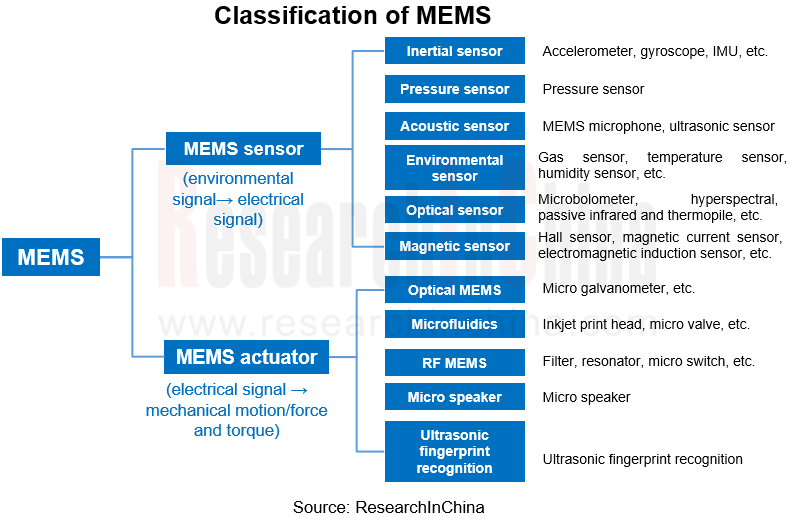
In the automotive field, MEMS sensors are widely used in automotive ADAS, intelligent cockpits, body comfort systems, powertrains and chassis systems. They find application in high-precision positioning, healthy cockpit (air quality), in-car heartbeat monitoring, smart car key, active noise reduction, heat pump air conditioner, airbag, engine, battery management system (BMS), electronic stability program, and anti-lock braking system (ABS), electronically controlled suspension and tire pressure monitoring system (TPMS).
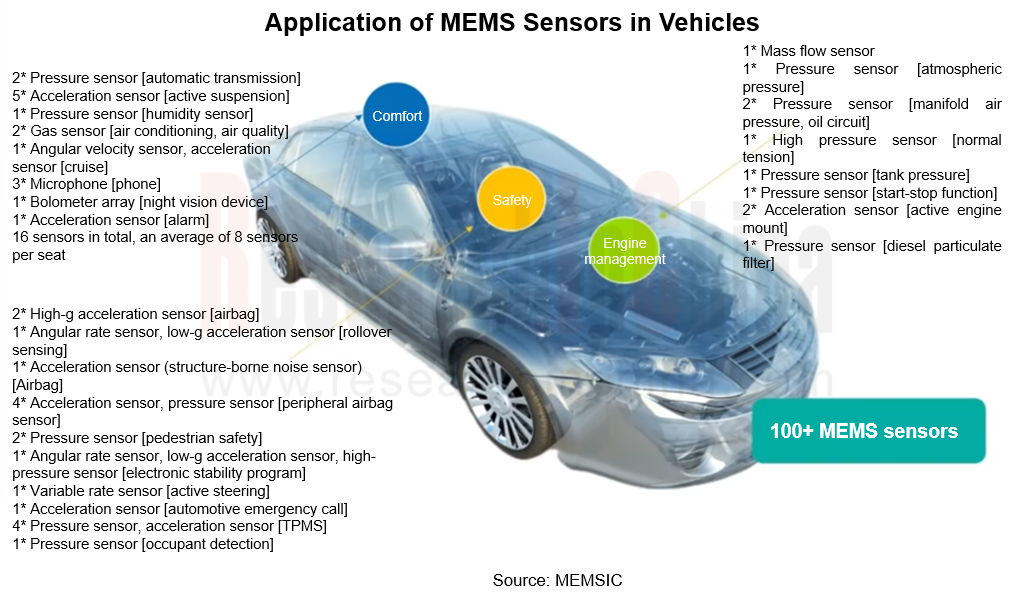
Among MEMS products for automotive applications, pressure sensors, inertial sensors and microphones employ the most MEMS sensors, sweeping 99% of automotive MEMS. In the future, with vehicle intelligence, system integration and the R&D of MEMS-related devices, more diversified MEMS sensors will be applied to vehicles.
MEMS inertial sensors: more MEMS IMUs will be applied in autonomous driving
MEMS inertial sensors are the basis for intelligent driving perception of new energy vehicles. They mainly include MEMS gyroscope, MEMS accelerometer, and MEMS IMU. They can be used to measure the acceleration and angular velocity of vehicles while driving, and provide real-time vehicle motion posture and trajectory. MEMS inertial sensors (accelerometer, gyroscope) were first used in airbags and electronic stability control systems. As autonomous driving develops, the application of MEMS IMUs in high-precision positioning and navigation scenarios has been expanded.
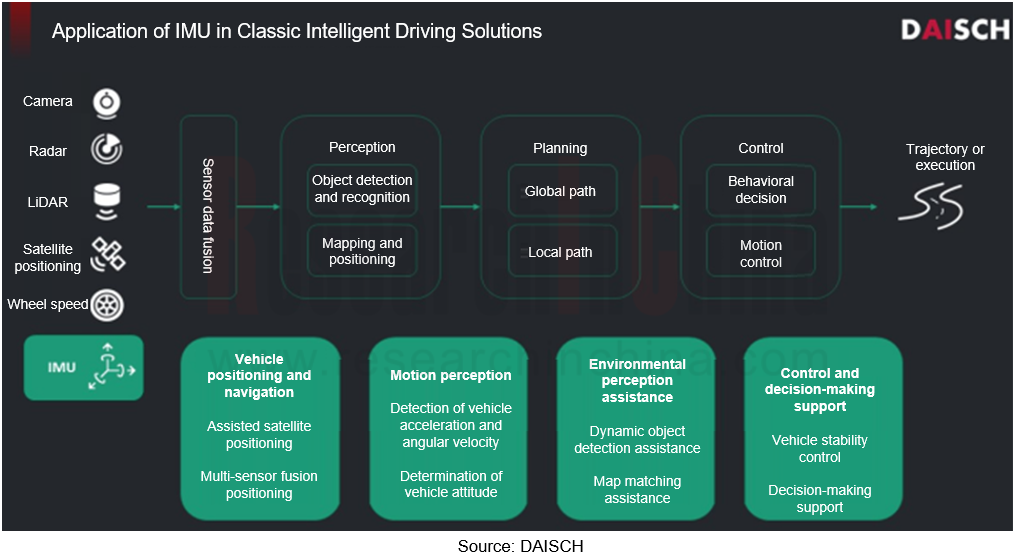
MEMS IMU integrates MEMS accelerometer, MEMS gyroscope, and motion/attitude algorithm. In classic intelligent driving scenarios, MEMS IMU is often used in modules and functions such as vehicle positioning and navigation, motion perception, environmental perception assistance, control and decision-making support.
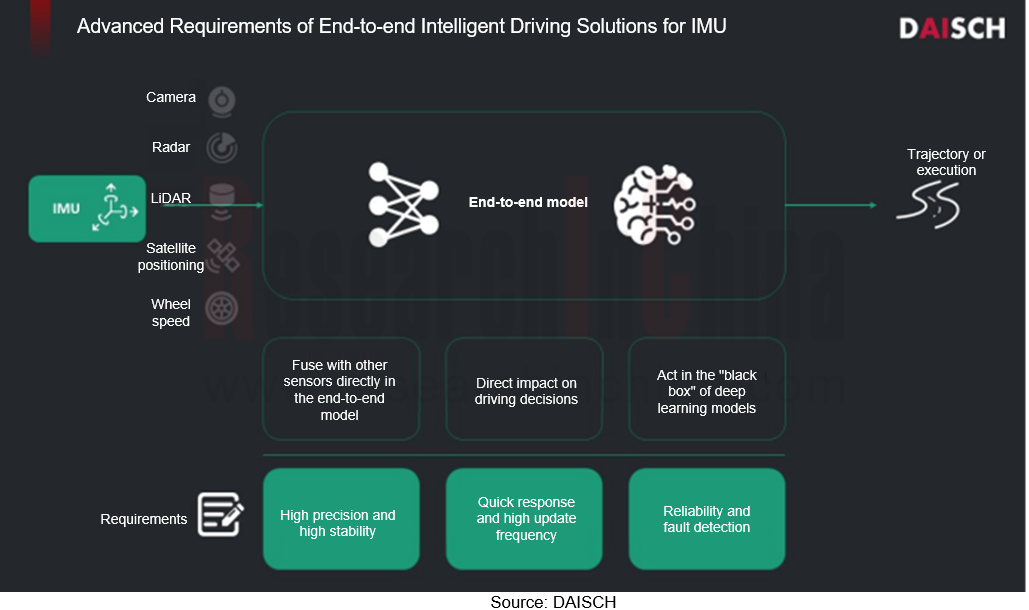
In end-to-end intelligent driving solutions, the solution of integrating IMUs into domain controllers has become the mainstream option. With the evolution of autonomous driving, vehicles have higher accuracy and safety requirements for perception and positioning. It is necessary to ensure that vehicle position information is highly accurate and reliable. In particular, L3/L3+ autonomous vehicles need to have higher-precision positioning. The requirements for MEMS IMUs will become ever higher:
High accuracy and stability: High-precision IMUs can provide more accurate vehicle attitude information to help systems better understand the position and direction of vehicles in space. Also the stability of IMUs is crucial to the reliability of systems. During long-term operation, IMUs need to maintain stable performance and output reliable data, without being affected by environmental factors such as temperature changes and vibration.
Quick response and high update frequency: End-to-end intelligent driving systems need to make a quick response to environmental changes, so IMUs need to respond quickly and update data frequently.
Compatibility with deep learning models: End-to-end intelligent driving systems generally use deep learning models to process sensor data, so IMUs need to provide data formats that are compatible with deep learning models.
High reliability and fault analysis: End-to-end intelligent driving systems pose extremely high safety requirements, including normal operation in various harsh environments such as high temperature, low temperature, high humidity and intense vibration, so IMUs need to offer high reliability. Moreover due to the complexity of end-to-end systems, IMUs need to have the ability to detect and diagnose faults. When IMU fails, the intelligent driving system can detect the failure in time and take corresponding measures, for example, switching to backup sensors or decelerating, so as to ensure the safety of the vehicle.
In November 2024, Murata Manufacturing Co., Ltd. unveiled its latest innovation in automotive sensor technology, the SCH1633-D01. The 6-axis MEMS inertial sensor is designed to meet the increasing demand for precision in autonomous driving (AD), advanced driver-assistance systems (ADAS), and other key automotive functions, including inertial navigation, vehicle stability control, and headlight alignment. It is the smallest product among Murata's automotive-grade IMUs.
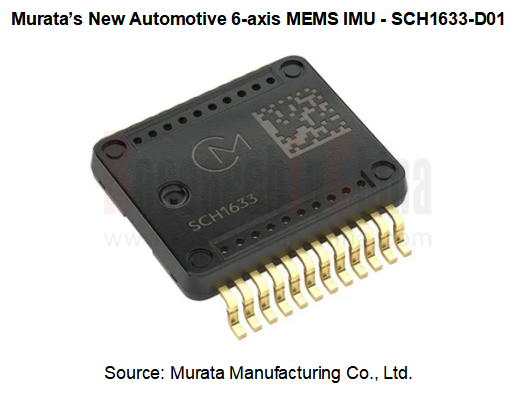
The automotive 6-axis MEMS IMU integrates a 3-axis accelerometer and a 3-axis gyroscope, with the acceleration range of ±8g, the angular velocity range of ±62.5dps~±300dps, and built-in orthogonal error compensation. It enables extremely smooth and high-resolution output. The IMU features time synchronization, providing the signals required for GNSS dead reckoning, vehicle attitude measurement, camera/LiDAR/radar tilt detection, to handle the time misalignment between these signals.
In the field of automotive MEMS IMU, most high-precision MEMS IMUs are imported. As China’s new energy vehicle industry gains an edge and opportunities, automotive MEMS IMUs made in China are accelerating the pace of replacing imports. Chinese companies such as QST, Asensing Technology, MT Microsystems, AAC Technologies, Huaxin Semiconductor, DAISCH and Aceinna are deploying automotive MEMS IMUs.
In July 2024, QST released new six-axis MEMS IMUs, QMI8A01 and QMI8A01z. QMI8A01z has been certified by AEC-Q100 Grade 2.
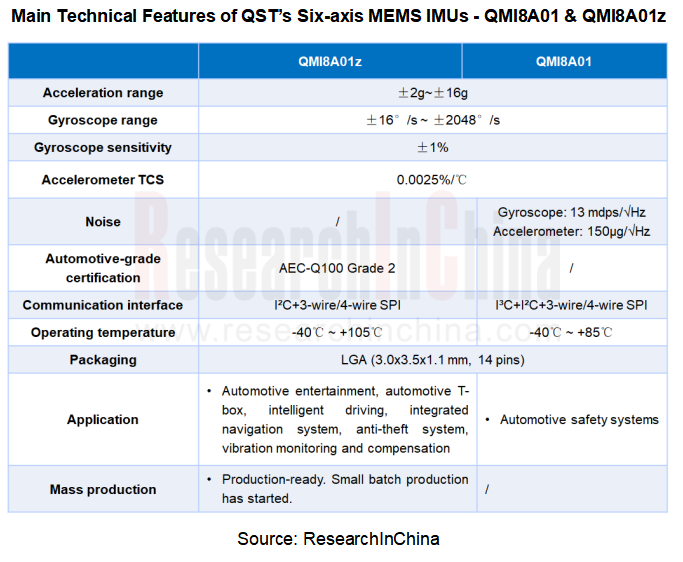
The board-level sensitivity error of the MEMS gyroscope in QMI8A01z reaches ±1%, and the TCS of the MEMS accelerometer is 0.0025%/℃. In harsh application scenarios, QMI8A01z can minimize the impact of the environment and help technicians develop more flexible algorithms. In addition, it supports SPI, I2C, and I3C communication protocols. To make it easier for application developers to develop, the sensor has a built-in intelligent algorithm which mainly integrates AnyMotion, No-Motion, and SignificantMotion to detect motion/stationary/continuous movement and output the corresponding interrupt signal.
MEMS pressure sensors: MEMS pressure sensors will be used more widely in thermal runaway monitoring.
MEMS pressure sensors are largely seen in the power domain, chassis domain and cockpit domain of vehicles. In traditional ICE vehicles, MEMS pressure sensors find broad application in pressure detection of gearboxes and engines. In the field of new energy vehicles, the rapid development of electric vehicles may mean that the demand for pressure sensors in the power systems of traditional ICE vehicles will slow down. Meanwhile, some new application scenarios for MEMS pressure sensors will also appear. For example, there are seat pressure sensors and heat pump air conditioning pressure and temperature composite sensors in the cockpit domain, and battery pack pressure sensors in the power domain. MEMS pressure sensors are expected to be used much more widely in thermal runaway monitoring in BMS.
At present, the power batteries for new energy vehicles are led by lithium batteries. Overcharge, over-discharge, overheating, short circuit, high temperature, extrusion, collision, water intrusion and so on may cause thermal runaway of battery packs. In the case of thermal runaway, multiple chemical reactions will occur inside battery packs, generating heat and gas and increasing internal pressure of the batteries. At this time, the pressure change in the battery pack can be detected by pressure sensors.
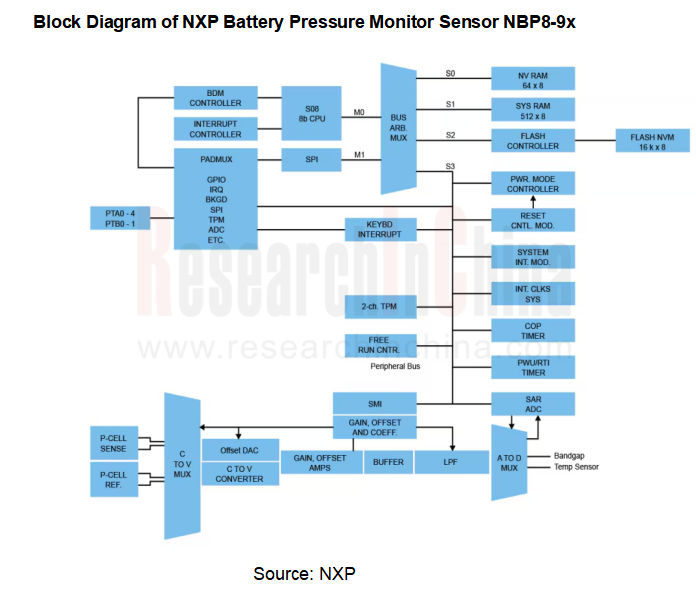
NXP NBP8 and NBP9 is a fully integrated battery pressure monitor sensor family. This solution has a built-in MCU and battery pressure monitor sensors (BPMS), and integrates an 8-bit central processing unit (CPU) and firmware provided by NXP. NBP8xx can detect pressure and wake up the main MCU when a change in pressure is detected. The pressure sensors located in the battery monitoring unit communicate with the main MCU which then notifies the driver to escape from the vehicle quickly before thermal runaway occurs.
MEMS microphones: Intelligent driving perception will boost automotive MEMS silicon microphones.
Automotive MEMS microphones can be used for in-vehicle and out-of-vehicle sound pickup. In-vehicle sound pickup applications mainly include hands-free calls, voice interaction, and active noise reduction. Out-of-vehicle sound pickup applications contain environmental perception and external voice pickup for road condition detection and (ambulance/police car) sirens detection.
ADAS generally collects data based on the position of cameras, radars or LiDAR and can only detect and recognize objects within its field of view. L3/L4 autonomous driving systems, there will be higher requirements for the detection of approaching emergency vehicles. L3/L4 autonomous driving requires vehicles to detect and respond to dynamic driving environments, such as ambulances, police cars and other emergency service vehicles. If the line of sight is blocked, vision-based perception is obviously unable to detect the approach of emergency vehicles in time.
Automotive MEMS microphones can provide vehicles with hearing capabilities, and perceive the approach of emergency vehicles in advance before visual sensors. Microphones with extremely high sensitivity can detect surrounding sounds without being heard by human ears, and warn of approaching objects in advance, leaving drivers or autonomous driving systems more time to respond, and improving the safety of the systems.
Infineon and Reality AI have jointly created an advanced sensing solution giving vehicles the sense of hearing. This solution adds XENSIV? MEMS microphones to existing sensor systems. It enables cars to “see” around the corner and to warn about moving objects hidden in the blind spot or approaching emergency vehicles that are still too distant to see.
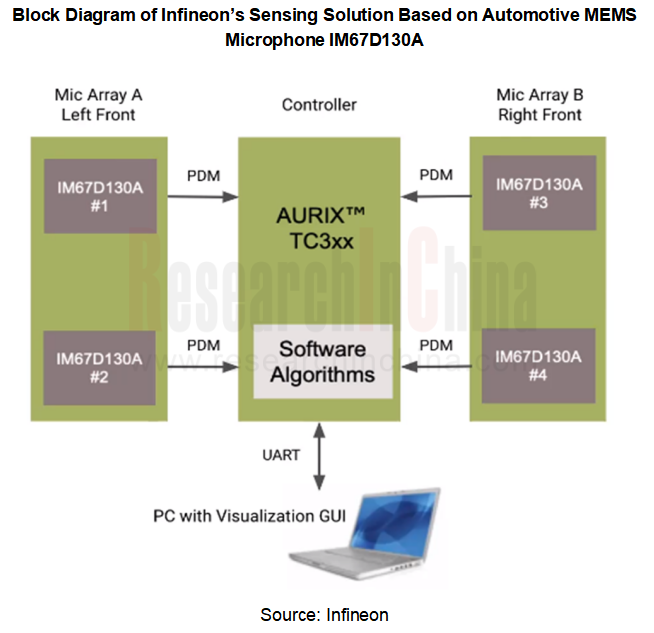
The new sensing solution is based on Infineon XENSIV? MEMS microphones (IM67D130A) in combination with AURIX? microcontrollers (MCU) and Reality AI’s Automotive See-With-Sound (SWS) system. Infineon IM67D130A has a low THD and an acoustic overload point (AOP) of 130dB SPL, which allows the automotive MEMS silicon microphone to capture distortion-free audio signals in noisy environments, thereby eliminating noise hidden in high background noise or wind noise and reliably recognizing alarm sounds in the system.
Using machine learning-based algorithms, the system is able to detect emergency vehicles, cars and other road participants – even if they cannot be seen by drivers or detected by the sensors incorporated in the vehicles’ ADAS. Machine learning also ensures that the country-specific sirens of emergency vehicles are recognized in all parts of the world.
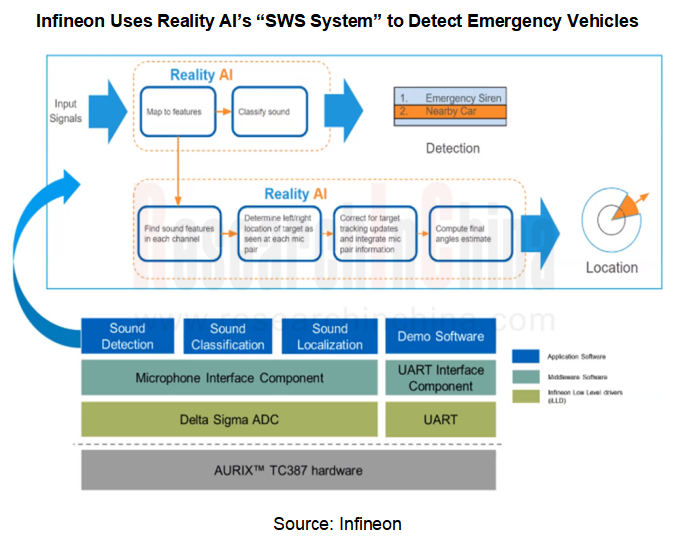
For processing the audio signal, the Reality AI software makes use of Infineon’s AURIX TC3x family of MCUs which is widely used across multiple automotive applications. The scalable MCU family offers a range from one to six cores and up to 16 MB of Flash with functional safety up to ASIL-D according to the ISO26262 2018 standard and EVITA full cybersecurity.
Autonomous Driving Domain Controller and Central Computing Unit (CCU) Industry Report, 2025
Research on Autonomous Driving Domain Controllers: Monthly Penetration Rate Exceeded 30% for the First Time, and 700T+ Ultrahigh-compute Domain Controller Products Are Rapidly Installed in Vehicles
L...
China Automotive Lighting and Ambient Lighting System Research Report, 2025
Automotive Lighting System Research: In 2025H1, Autonomous Driving System (ADS) Marker Lamps Saw an 11-Fold Year-on-Year Growth and the Installation Rate of Automotive LED Lighting Approached 90...
Ecological Domain and Automotive Hardware Expansion Research Report, 2025
ResearchInChina has released the Ecological Domain and Automotive Hardware Expansion Research Report, 2025, which delves into the application of various automotive extended hardware, supplier ecologic...
Automotive Seating Innovation Technology Trend Research Report, 2025
Automotive Seating Research: With Popularization of Comfort Functions, How to Properly "Stack Functions" for Seating?
This report studies the status quo of seating technologies and functions in aspe...
Research Report on Chinese Suppliers’ Overseas Layout of Intelligent Driving, 2025
Research on Overseas Layout of Intelligent Driving: There Are Multiple Challenges in Overseas Layout, and Light-Asset Cooperation with Foreign Suppliers Emerges as the Optimal Solution at Present
20...
High-Voltage Power Supply in New Energy Vehicle (BMS, BDU, Relay, Integrated Battery Box) Research Report, 2025
The high-voltage power supply system is a core component of new energy vehicles. The battery pack serves as the central energy source, with the capacity of power battery affecting the vehicle's range,...
Automotive Radio Frequency System-on-Chip (RF SoC) and Module Research Report, 2025
Automotive RF SoC Research: The Pace of Introducing "Nerve Endings" such as UWB, NTN Satellite Communication, NearLink, and WIFI into Intelligent Vehicles Quickens
RF SoC (Radio Frequency Syst...
Automotive Power Management ICs and Signal Chain Chips Industry Research Report, 2025
Analog chips are used to process continuous analog signals from the natural world, such as light, sound, electricity/magnetism, position/speed/acceleration, and temperature. They are mainly composed o...
Global and China Electronic Rearview Mirror Industry Report, 2025
Based on the installation location, electronic rearview mirrors can be divided into electronic interior rearview mirrors (i.e., streaming media rearview mirrors) and electronic exterior rearview mirro...
Intelligent Cockpit Tier 1 Supplier Research Report, 2025 (Chinese Companies)
Intelligent Cockpit Tier1 Suppliers Research: Emerging AI Cockpit Products Fuel Layout of Full-Scenario Cockpit Ecosystem
This report mainly analyzes the current layout, innovative products, and deve...
Next-generation Central and Zonal Communication Network Topology and Chip Industry Research Report, 2025
The automotive E/E architecture is evolving towards a "central computing + zonal control" architecture, where the central computing platform is responsible for high-computing-power tasks, and zonal co...
Vehicle-road-cloud Integration and C-V2X Industry Research Report, 2025
Vehicle-side C-V2X Application Scenarios: Transition from R16 to R17, Providing a Communication Base for High-level Autonomous Driving, with the C-V2X On-board Explosion Period Approaching
In 2024, t...
Intelligent Cockpit Patent Analysis Report, 2025
Patent Trend: Three Major Directions of Intelligent Cockpits in 2025
This report explores the development trends of cutting-edge intelligent cockpits from the perspective of patents. The research sco...
Smart Car Information Security (Cybersecurity and Data Security) Research Report, 2025
Research on Automotive Information Security: AI Fusion Intelligent Protection and Ecological Collaboration Ensure Cybersecurity and Data Security
At present, what are the security risks faced by inte...
New Energy Vehicle 800-1000V High-Voltage Architecture and Supply Chain Research Report, 2025
Research on 800-1000V Architecture: to be installed in over 7 million vehicles in 2030, marking the arrival of the era of full-domain high voltage and megawatt supercharging.
In 2025, the 800-1000V h...
Foreign Tier 1 ADAS Suppliers Industry Research Report 2025
Research on Overseas Tier 1 ADAS Suppliers: Three Paths for Foreign Enterprises to Transfer to NOA
Foreign Tier 1 ADAS suppliers are obviously lagging behind in the field of NOA.
In 2024, Aptiv (2.6...
VLA Large Model Applications in Automotive and Robotics Research Report, 2025
ResearchInChina releases "VLA Large Model Applications in Automotive and Robotics Research Report, 2025": The report summarizes and analyzes the technical origin, development stages, application cases...
OEMs’ Next-generation In-vehicle Infotainment (IVI) System Trends Report, 2025
ResearchInChina releases the "OEMs’ Next-generation In-vehicle Infotainment (IVI) System Trends Report, 2025", which sorts out iterative development context of mainstream automakers in terms of infota...